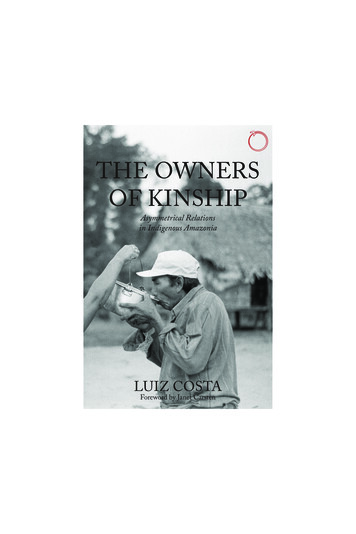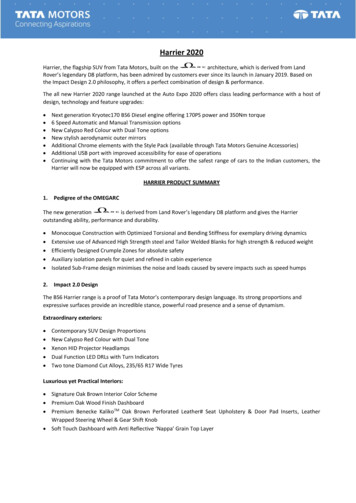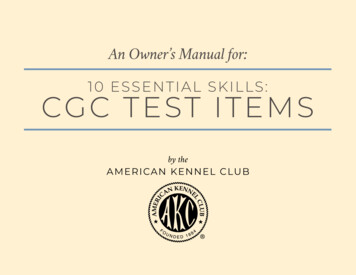
Transcription
THE OWNERS OF KINSHIP
HauBOOKSExecutive EditorGiovanni da ColManaging EditorKatharine HermanEditorial BoardCarlos FaustoIlana GershonMichael LempertStephan PalmiéJonathan ParryJoel RobbinsDanilyn RutherfordAnne-Christine TaylorJason Throopwww.haubooks.com
The Malinowski MonographsIn tribute to the foundational, yet productively contentious,nature of the ethnographic imagination in anthropology, thisseries honors the creator of the term “ethnographic theory” himself.Monographs included in this series represent unique contributionsto anthropology and showcase groundbreaking work thatcontributes to the emergence of new ethnographically-inspiredtheories or challenge the way the “ethnographic” is conceived today.Hau Books
THE OWNERS OF KINSHIPASYMMETRICAL RELATIONS ININDIGENOUS AMAZONIALuiz CostaHau BooksChicago
2017 Hau Books and Luiz CostaCover, Luiz CostaForeword, 2017 Hau Books and Janet CarstenCover and layout design: Sheehan MooreTypesetting: Prepress Plus (www.prepressplus.in)ISBN: 978-1-912808-15-1LCCN: 2017917362Hau BooksChicago Distribution Center11030 S. LangleyChicago, IL 60628www.haubooks.comHau Books is printed, marketed, and distributed by The University of Chicago Press.www.press.uchicago.eduPrinted in the United States of America on acid-free paper.
To Joana, Antonio, and Manoel
Dominance may be cruel and exploitative, with no hint of affection in it. Whatit produces is the victim. On the other hand, dominance may be combined withaffection, and what it produces is the pet.Yi-Fu Tuan, Dominance and affection: The making of pets
Table of ContentsList of figuresAcknowledgmentsNote on orthographyxixiiixixForewordJanet CarstenxxiIntroduction1chapter oneMaking need23chapter twoMastering agency59chapter threeOn the child’s blood97chapter fourTripartite history137
xTHE OWNERS OF KINSHIPchapter fiveOld jaguars185Conclusion223References citedIndexes235263
List of figuresFigure 1. Location of the Kanamari and their neighbors.Figure 2. Tsamuha and his birds.Figure 3. Infant pet spider monkey tied to a shelter.Figure 4. Hak (house) built in a village as a durable structure for a family.Figure 5. Dyaniohak shelters built quickly on a trail during travels.Figure 6. Pet saki monkey.Figure 7. Wooly monkey and his jaguar-pattern hammock.Figure 8. Kanamari canoe packed with merchandise.Figure 9. Livestock must obtain food that falls from raised houses.Figure 10. Ihnan, Ioho’s only surviving son.Figure 11. Pregnant woman eating alone.Figure 12. Midwife washing newborn in herbal bath.Figure 13. Boy and his pet coati.Figure 14. Autonomous teenage boys visiting a village.Figure 15. Autonomous teenage girl ready for travel.Figure 16. Location of the Curassow-dyapa in the Komaronhu river basin,c. 1900.Figure 17. The Kanamari village of Kumaru on the Itaquaí River.Figure 18. Map of -tawari relations on the left banks of the Juruá, c. 1900.Figure 19. Man blowing the hori horn on arrival at a guest’s village.Figure 20. Tapir-skin fight between -tawari.Figure 21. Injuries resulting from a tapir-skin fight.
xiiTHE OWNERS OF KINSHIPFigure 22. A row of “worthless ancestresses” serving manioc beer to maleguests.Figure 23. Village of Massapê with Funai’s outpost house in the foreground.Figure 24. Funai’s outpost house in Massapê.Figure 25. Kanamari man’s arm tattooed with the Brazilian coat of arms. Theinverted design was traced from a decal inside a window of a government boat.Figure 26. Maps of migrations toward the Juruá and Itaquaí river basins,1920s–1940s.Figure 27. Location of Kanamari villages in the Itaquaí river basin, 1940s–2016.Figure 28. Conceptual relations among Hohdom, Sabá, and Jarado.Figure 29. The Juruá regional system.Figure 30. Men wearing palm-bark vestments during Jaguar-becoming ritual.Figure 31. Women learning songs from Jaguar performers.
AcknowledgmentsThis book is based on research carried out for my doctoral thesis, presented atthe Museu Nacional, Universidade Federal do Rio de Janeiro (National Museum, UFRJ, Federal University of Rio de Janeiro), in 2007. My time as a graduate student was made possible by a scholarship from the Conselho Nacional deDesenvolvimento Científico e Tecnológico (CNPq, the National Council forScientific and Technological Development). Fieldwork among the Kanamari ofthe Itaquaí River was funded by the CNPq, the Wenner-Gren Foundation forAnthropological Research, the Programa de Pós-Graduação em AntropologiaSocial do Museu Nacional (PPGAS, Graduate Program in Social Anthropology at the National Museum), and the Centro de Trabalho Indigenista (CTI,Center for Indigenist Work). Subsequent postdoctoral work was funded by theFundação de Amparo à Pesquisa do Estado do Rio de Janeiro (FAPERJ, Research Support Foundation of the State of Rio de Janeiro) and the Coordenação de Aperfeiçoamento de Pessoal de Nível Superior (Capes, CoordinatingAgency for Advanced Training in Graduate Education). I thank all of theseinstitutions for their support.My career in anthropology owes everything to Carlos Fausto, who has encouraged me since day one at the Museu Nacional. He has remained my mostimportant critic, supporter, and collaborator. This book exists because he insisted that I write it and then commented on everything I wrote. Readers willeasily gauge how crucial his ideas are for my analysis of the Kanamari. Evenmore profoundly, he is one of my best friends, someone who is always there forme and my family. I could never thank him enough.
xivTHE OWNERS OF KINSHIPI consider myself very fortunate to have been an undergraduate at the University of Oxford. Barbara Kennedy (in memoriam) took a chance on me whenno one else would. Peter Rivière introduced me to the anthropology of lowland South America. He once told me that if I wanted to become a SouthAmericanist, I should return to Brazil and study at the Museu Nacional. It wasone of the best and most generous pieces of advice I have ever been given. PeterMitchell supervised me in college. He was responsible for most of my courses,took me on an archaeological excavation in Africa, and showed me how excitingacademia could be.The Museu Nacional was an exceptional place to learn anthropology. Iwould like to thank Lygia Siguad (in memoriam), Gilberto Velho (in memoriam),Federico Neiburg, and Antonio Carlos de Souza Lima for their patience, help,and encouragement. Meeting Eduardo Viveiros de Castro while at Oxford wasone of my main incentives to study at the Museu Nacional, where he teaches.He remains an unending source of inspiration. Bruna Franchetto taught me theimportance of language, and I hope her influence shows in this book. AparecidaVilaça is a fantastic anthropologist. I learned how to do fieldwork by followingher example and taking her suggestions seriously.My contemporaries at the Museu Nacional taught me much and made mygraduate career great fun. I thank Pedro Cesarino, Paulo Maia, Anne-MarieColpron, Roberto Salviani, Marcela Coelho de Souza, Oiara Bonilla, BeatrizMatos, Cristiane Lasmar, Roberta Ceva, Célia Collet, Gustavo Barbosa, JoséAntonio Kelly, and Flávio Gordon. Elena Welper is one of the best people Iknow.Many people read all or part of this book or responded to oral presentationsof its arguments, and their comments have been essential. I thank Rupert Stasch,Paul Kockelman, Cesar Gordon, Hanne Veber, Pirjo Virtanen, Maria Barroso,Marc Brightman, Vanessa Grotti, Miguel Aparício, Jean-Baptiste Eczet, PeterGow, Cecilia McCallum, Els Lagrou, Anne-Christine Taylor, Philippe Descola,Carlo Severi, Philippe Erikson, Jean-Pierre Chaumeil, Bonnie Chaumeil,Isabelle Daillant, Nathalie Petesch, Patrick Menget, Emmanuel De Vienne,Mike Cepek, Magnus Course, Jean Langdon, Ruy Blanes, Veena Das, DanilynRutherford, and Andrew Shryock.Giovanni da Col believed in this book when it was just a draft. I thank himfor his encouragement, his unwavering support and patience, and his uncompromising dedication to rigorous anthropology. The Hau Books editorial teamhas been outstanding. I would like to thank Sean Dowdy, Kate Herman, and
ACKNOWLEDGMENTSxvSheehan Moore for their help in getting the text ready. I had two of the bestreviewers of Amazonian anthropology work on this book: David Rodgers andCatherine V. Howard. Catherine, in particular, reviewed the manuscript witha meticulous eye for detail, and her suggestions have improved the text enormously. It is a great honor to have Janet Carsten, whose work on kinship hasinspired my own, write the foreword to the book.I thank my colleagues at the Departamento de Antropologia Cultural(Department of Cultural Anthropology) and the Programa de Pós-Graduaçãoem Sociologia e Antropologia (PPGSA, Graduate Program in Sociology andAnthropology) of the Instituto de Filosofia e Ciências Sociais da Universidade Federal do Rio de Janeiro (IFCS-UFRJ, Institute of Philosophy andSocial Sciences, Federal University of Rio de Janeiro). In particular I wouldlike to thank Marco Antonio Gonçalves, Els Lagrou, Cesar Gordon, FernandoRabossi, Maria Barroso, Maria Laura Viveiros de Castro, Karina Kuschnir, JúliaO’Donnell, Marco Aurélio Santana, and Alexandre Werneck.The researchers at the Laboratório de Antropologia da Arte, do Ritual eda Memória (Larme, Laboratory for the Anthropology of Art, Ritual, andMemory) at the Museu Nacional have helped in a great many ways. I wouldparticularly like to thank Thiago Oliveira, Hélio Sá Neto, Luana Almeida,Messias Basques, Ana Coutinho, and Maria Luísa Lucas. A number of my students or former ones have helped me become a better anthropologist. I wouldparticularly like to thank Danielle Araujo Bueno, Paulo Büll, Thayná Ferraz,and João Caldeira.I am part of a generation of ethnographers who began fieldwork in the Valedo Javari under the auspices of the nongovernmental organization Centro deTrabalho Indigenista (CTI). I owe them so much: an opportunity, a start, ahome away from home, logistical help, mentoring, friendship, and care. I wouldspecifically like to thank Maria Auxiliadora Leão, Gilberto Azanha, Maria ElisaLadeira, Conrado von Brixen, Helena Ladeira, and Hilton Nascimento (Kiko).More recently, I’ve had the privilege of becoming friends with Victor Gil, whohelped me with all the maps and diagrams in this book. I also thank CTI forallowing me to include photographs from their archives in this book.I would also like to thank the Regional Administration of the FundaçãoNacional do Índio (Funai, the National Indian Agency) in Atalaia do Nortefor making my time in the field free of hassle. The people of the Frente deProteção Etno-Ambiental do Vale do Javari (FPEVJ, the EthnoenvironmentalProtection Front of the Javari Valley) played an important part at the start of
xviTHE OWNERS OF KINSHIPmy fieldwork. This is particularly true of Idinilda, a very dear person who hashelped all fieldworkers who have gone through Tabatinga. I also acknowledgethe support of the (former) Conselho Indígena do Vale do Javari (CIVAJA,Javari Valley Indigenous Council) and the Associação Kanamari do Vale doJavari (Kanamari Association of the Javari Valley). I thank Jorge Marubo, ClóvisRufino Reis, Toda Kanamari, Adelson Kanamari (Kora), and André Mayoruna.I spent a lot of time in Atalaia do Norte, where many people made me feel athome. I would like to thank Mr. Nonato, Tirim, Nery, Almério Alves Wadik(Kel) and his wife Francisca, and Gauça and Mara for their help in the field, andMr. Dino, Mrs. Maria, and their daughter Mariquinha and her husband Moacyrfor housing me in Atalaia do Norte.I do not think I would have been able to stay in the field at all if not for theunconditional assistance and care provided by the former outpost chief of theKanamari village of Massapê, Micherlângelo Neves, and his wife Raimunda.They put me up in the Funai post for much of my fieldwork, fed me, took me toall of the villages, took me back and forth from Atalaia do Norte and helped mesend things to the Kanamari.Back in Rio, my affinal kin have always been fantastic. I thank Jeanne-MarieCosta Ribeiro and Carlos Antonio Moita for helping with the boys while Iwrote this book, and for much more. Yvonne Maggie is family, colleague, andfriend. Without her constant support, both personal and professional, littlewould be possible.My parents, Bebel and Fausto, have always encouraged me, even whenthey weren’t quite sure of what I was doing and when it took me very far awayfrom them. The same is true of my grandparents, Manoel (in memoriam) andMyriam (in memoriam), who took me in as only grandparents can. I also thankMiguel, Anna Maria Lino Costa, Maria Thereza Lino Costa, Antonio CarlosLino Costa, and Paula Salles and her family. My friends Afonso, Vasco, DanielRosário, Daniel Ernst, Joe, André, Fred, João Lima, Carl, Marco, and Christianhave always put up with and encouraged me.Joana, Antonio, and Manoel are why I do everything. This book is for them.Living with the Kanamari is a wonderful experience. I cannot think of asingle one among them who did not help me at some point, and even thosewho appeared to be suspicious of my real motives treated me with dignity andeven affection. As I come to name those that helped me most, I realize howunfair I will have to be. But since this book results from the conversations thatI had with some of them, for many months on end, I specially thank Dyumi,
ACKNOWLEDGMENTSxviiJoão Pidah, Kodoh, Dyan, Inore, Wahpaka, Meran Meran, Dyanim, Hanani,Marinawa, Paiko Nui, Wadyo, Tyomi, Apan, and Iun.It was Poroya, however, who had been waiting for me on that evening inApril of 2002. It was dark and we could not see each other, but the followingmorning he saw my sullen, sleepy face and laughed, as if he knew everythingall along. In time, he made himself into my grandfather. I once told him thatI happened upon the Kanamari by chance, that I very nearly went to live withtheir neighbors, the Marubo. He explained to me that I was mistaken, becausea long time ago he had foreseen my arrival in a vision and had been waiting forme to show up, to learn the stories of the Kanamari and teach them to whitepeople, so that we, too, would know a little about them. This book carries withit a heavy responsibility.Han paiko. Itanti inowa ankira nuk tyo.
OrthographyThe orthography of Katukina-Kanamari that I use in this book is mostly basedon that developed by Francisco Queixalós and Zoraide dos Anjos. It includessome differences in relation to their published phonetic studies (e.g., Queixalósand Dos Anjos 2006; Dos Anjos 2012), since I have taken into account theorthographic solutions that were being advanced by young Kanamari schoolteachers at the time.Vowelsaiouylike the a in “pattern”varying between the i in “bit” and the ee “meet”like the ow in “slow”like the u in “strut”like the y in “player”Consonantsblike the b in “bat”dlike the d in “dance”hlike the h in “behind”klike the k in “karma”mlike the m in “man”nlike the n in “nice”tlike the t in “tan”ralveolar tap, like the tt in American English “latter”
xxwdyty’THE OWNERS OF KINSHIPlike the wh in “what”like the j in “jam”like the tch in “match”glottal stopSome of the Kanamari nouns that I discuss in this book occur as elementsof noun phrases, where they are always preceded by morphemes or lexemes.When I discuss these nouns without their complements, I mark the absence bya hyphen (-warah, -tawari). The use of the hyphen is important to my analysis,because some words that occur within noun phrases, where they are necessarilybound, can also occur as independent nouns or even as verbs, where they displaydifferent semantic qualities. In these cases, I drop the hyphen (cf. -warah andwarah).Since many of the ethnographies from which I quote passages are inPortuguese or French, I have supplied my own translations into English asneeded, without further parenthetical annotation.
ForewordJanet CarstenHow do ethnographies speak to each other across regions? What resonances, insights, or common themes might an anthropologist schooled in one geographicalarea find in a study of kinship in a region thousands of miles distant from herscholarly “home” territory? These questions inform my reading of Luiz Costa’sintricate and profound exploration of the logic and meanings of Kanamarikinship. I come to this work not as an expert on the indigenous societies ofAmazonia but as a Southeast Asianist—and all too conscious of the pitfalls thisentails. But a belief in the potential value of such conversations is a fundamentaltenet of anthropology, and this book is a testament to its continuing pertinence.Set primarily in the context of studies of indigenous Amazonia, Luiz Costaundertakes a forensic investigation of the salient elements of Kanamari kinshipto show the connectedness and coherence of its central themes: feeding, “ownership,” dependence, and commensality. What, in local understandings, enableskinship relations to be made? To find answers to this question, we are guidedthrough their constituent aspects, taking in relations with pets, the place ofchildren, fosterage, blood, the importance of indigenous chiefs, and of relationswith whites (from the early years of the twentieth century during the rubberboom to the contemporary significance of Brazilian state agencies), as well asritual and myth. Time and again, Costa returns to the centrality of feeding andto the relations of asymmetry on which they are premised.
xxiiTHE OWNERS OF KINSHIPThe philosophical questions that Kanamari people grapple with—andwhich their kinship can be understood to endlessly explore from differentangles—are perhaps fundamental to all humanity. What does it mean to beobligated to another? What are the connotations of dependence? How can autonomy and predation be kept in balance? The owners of kinship shows us howthe Kanamari tackle these questions, their relative importance, and the answersapparently provided by kinship as a constellation of practices and a “philosophy concerned with human obligation,” as Robert McKinley (2001: 152) hasphrased it. But perhaps “the provision of answers” to questions is not quite onthe mark here. Rather, as one might infer from McKinley’s apt encapsulation,beyond what people do, kinship is also a realm of speculation about the important relations and qualities of life—the things and people that make life worthliving but which also plague us, and which underlie social disjunctures as wellas continuities.The echoes between Kanamari and Southeast Asian ethnography are striking—demonstrated, for example, in the prominence of ideas about food andblood, the centrality of children, and in widespread fostering relations. But, asif to discourage such easy analogies, there are some profound dissimilarities. Aswith a twist of a kaleidoscope, the pieces have been shaken up and arrangedto produce quite different geometric patterns. This is not, however, a matter ofmere aesthetic arrangements as the outcome of some untrammeled thought experiment. More profoundly, such contrasts are shown to be the historical issueof relations and circumstances that have no endpoint but continue to changeand evolve in local and regional contexts. The outcomes, it turns out, may beperilous for those concerned.Whereas in the parts of Southeast Asia with which I am most familiar,kinship could be said to be predicated on the reproduction of relations that arebased on similarity, and which is elaborated in terms of local ideas about siblingship, among the Kanamari, the fundamental premise of kinship—as otherstudies of Amazonia have demonstrated—is the condition of alterity. Moststarkly, this is embodied in the babies who, after birth, are considered not asclose relatives of their parents but as alters. Pregnancy and birth itself threatenthe well-being of a baby’s parents through premature aging, and Costa showshow Kanamari couvade rituals are aimed at protecting a baby’s close kin. Thisdanger is materialized in the child’s blood, which not only encapsulates thesoul but is particularly dangerous, because the child has not yet been made thesubject of feeding. The newborn’s blood is therefore as alien as the blood of an
FOREWORDxxiiienemy, and blood in general encapsulates danger and alterity. Through feeding,first with breast milk and subsequently with food by their mothers, babies andchildren are gradually turned into kin with whom relations of commensality areestablished. In turn, this feeding is predicated upon ideas about dependence, hierarchy, and ownership—principles that also underlie relations with local chiefswho are conceived as the source and owners of the food that kin of one locality share. Significantly, however, it is not with relations between mothers andchildren that Costa begins his exposition of Kanamari kinship but, rather, withrelations between women and pets.This choice of starting point turns out to be revelatory. Women rear petsand thus come to be the body-owners of the latter, as they are also of their ownchildren. Pet-feeding, like child-rearing, converts what is foreign and exteriorinto something familiar and interior. The parallel also contains a crucial difference: whereas human children are gradually incorporated into the world ofkin, the feeding relations with pets do not develop into kinship. Pets may neverbe eaten; instead, they may be items of exchange with white people. Kanamarialso rear livestock, which they do not themselves eat, for white people. Theseexchanges, along with others, in fact inhibit feeding relations, and white peopleare regarded as cannibals insofar as they eat the animals they rear. Images ofcannibalism are also tellingly present in the rituals of force-feeding that wereperformed in the past between different Kanamari subgroups who were not kinto each other. These rituals of alliance, we are told, acted to inhibit relations offeeding and kinship but were conceived as having a regenerative capacity, rendering the forest fertile and thus enabling future feeding.The truncated kinship of pets thus reveals the fundamental condition ofalterity on which the edifice of the Kanamari cosmos is constructed. Whereascognatic kinship in the Malay world, one might say, amplifies the sameness ofsiblings and the absorption of similar others as affines to create further similarity in the future, here the cosmos is created from differences, which carry thepredatory mark of cannibalism. While blood in Malay ideas is both a vital fluidand an idiom of shared identity (children share blood with their mothers andwith their siblings), for the Kanamari, for whom likewise it is a “vital principle,”blood is also highly dangerous, predatory, and crucially, not a source of sharedidentity. It is feeding that initiates and constructs kinship and the emotions withwhich it is associated. Considering these two quite different (and yet somehowresonating) versions of kinship from across the world together also brings tomind that cognatic kinship in Southeast Asia has its own more local mirror
xxivTHE OWNERS OF KINSHIPimage in the asymmetric alliance systems of eastern Indonesia, which hinge onthe symbolic elaboration of differences between cross-sex siblings.There are, after all, relatively few primary themes with which human kinshipis generally concerned. Among these, sameness and difference, interiority andexteriority, dependence and autonomy figure largely, and may be projected ontorelationships, objects, materials, and practices. While particular constellations ofthese have an aesthetic logic, their significance becomes clear in historical time.As Costa unpeels the different aspects of Kanamari kinship, we gradually cometo understand how it enfolds loss. Exploitative exchanges with whites in theearly and mid–twentieth century, especially in rubber plantations, have gradually been succeeded by relations with the Brazilian state that are conceived inmore beneficent terms. But a return visit ten years after initial fieldwork showshow the munificence of the state carries a lethal and predatory effect. Formerhouses and communities are gone. State support does not allow alterity; insteadit entails absorption. Kinship, as this book makes compellingly clear, requiresexteriority and asymmetry for reproduction to occur.REFERENCEMcKinley, Robert. 2001. “The philosophy of kinship: A reply to Schneider’sCritique of the study of kinship.” In The cultural analysis of kinship: The legacy ofDavid M. Schneider, edited by Richard Feinberg and Martin Oppenheimer,131–167. Urbana and Chicago: University of Illinois Press.
IntroductionDuring the first months of fieldwork in the Itaquaí River, I would spend myevenings crafting questions to put to my hosts. Riddled with the grammatical mistakes and naïvetés of a beginner, these questions helped me learn theKanamari language and served as a sort of dress rehearsal for future fieldwork,when I hoped my fluency would improve. One day, a man told me that thechiefs of old were very large and beautiful, and they never aged or fell ill. Thatnight, I strung together the following admittedly shoddy question: “How werethe bodies of long-ago chiefs”?One of the first Kanamari words I learned was -warah, which I initiallyunderstood to mean “owner” but which, it soon became clear to me, also meant“chief.” There is nothing particularly exceptional about this. In numerousAmazonian languages, the chief is called an “owner” or an “owner of people”or some similar composite phrase. Thus, the Carib cognates entu (Trio) and oto(Kuikuro) designate both the owner of things and of the village, thereby comingto mean “chief ” (Heckenberger 2005; Brightman 2007: 83–84). In Panoan languages, chiefs are typically designated by words that mean “owner” or “master,”such as the Kaxinawá ibo or the Marubo ivo (McCallum 2001: 33, 111–112;Cesarino 2016). The Kanamari -warah seemed to be a further interesting example of a common semantic feature of Amazonian languages.Secure in my translation for “chief,” I scanned my limited vocabulary for aword for “body.” I initially considered tyon, which more accurately refers to the“torso.” In the end, I settled on boroh, which I had heard applied to the corpses
2THE OWNERS OF KINSHIPof dead animals. I assumed that it also meant “body,” much as we use “body”to mean “corpse.” Although I had doubts about its syntax, I was confident myquestion would be understood.The next day, I tried it out on Poroya, my Kanamari grandfather. Like allKanamari, he was highly tolerant of my linguistic errors and always did hisbest to infer my intended meaning. My question about ancient chiefs, however, was incomprehensible to him. Disappointed at my failure, I surrenderedand repeated the question in Portuguese. Poroya had worked for over twodecades with Brazilian rubber tappers and loggers, so he spoke Portuguesebetter than most Kanamari. He told me that my question made no sense because the word boroh only means “corpse,” and a corpse is a corpse, whether achief ’s or a commoner’s. The correct word for “(living) body,” he explained, is-warah. I thought we were talking past each other. I already knew that -warahdesignated the “chief,” and I had just learned that boroh means “corpse.” WhatI needed to know was the Kanamari word for “body.” Poroya, who had aknack for diagnosing my perplexities, explained the Kanamari “body” to meby saying, in Portuguese, that “our body is our owner and our chief ” (nossocorpo é nosso dono e nosso chefe). I later learned that it is impossible to say thisphrase as such in the Kanamari language, since all the nouns would translateas -warah. Nor would such a sentence be able to distinguish semantic roles,because “body,” “owner,” and “chief ” are imperfect glosses for what, in theKanamari language, is one concept. Indeed, the sudden shift from the plural“our” to the singular “body is ” was an indication that more than synonymywas at stake.What Poroya told me was disconcerting. How could one word mean both“body” and “owner”? Had I misheard or misinterpreted something? As my initial unease subsided, I gradually came to realize that my research had foundits course via an ill-formed question and the implications of its startling reply.Although this brought me a measure of anxiety, I took comfort in the fact thatmy predicament was the lot of the ethnographer. Evans-Pritchard, perhaps thefinest ethnographer in the history of the social sciences, once wrote:[A]s every experienced fieldworker knows, the most difficult task in anthropo-logical fieldwork is to determine the meanings of a few key words, upon anunderstanding of which the success of the whole investigation depends; and theycan only be determined by the anthropologist himself learning to use the wordscorrectly in his converse with the natives. (Evans-Pritchard 1962: 80)
INTRODUCTION3Evans-Pritchard did not mean that anthropologists should be linguists, althoughhe certainly knew that anthropology is a kind of translation (Evans-Pritchard1962: 61–63; 1969). What he meant is that, during the course of our fieldwork,we learn certain words that so thoroughly defamiliarize our own vocabulary andso pressingly demand that we adjust our beliefs and expectations that we arecompelled to anchor our research in their meanings and commit ourselves toexploring their consequences. These words can only be learned by directly engaging with the language and the people who speak it over a long period of time.Evans-Pritchard was conceding that our ethnographies often hinge on a fleeting moment in which we learn the meaning of a word, but these moments willremain missed opportunities for ethnographers who do not then take the timeto map out all of their consequences through careful ethnographic investigation.Exploring the contexts when the Kanamari use the term -warah, I graduallydiscovered that it is structured by a specific relation. The bond between a chiefand his followers, it turned out, was only one possible actualization of a muchmor
Books is printed, marketed, and distributed by #e University of Chicago Press. . and Antonio Carlos de Souza Lima for their patience, help, . I’ve had the privilege of becoming friends with Victor Gil, who helped me with all










